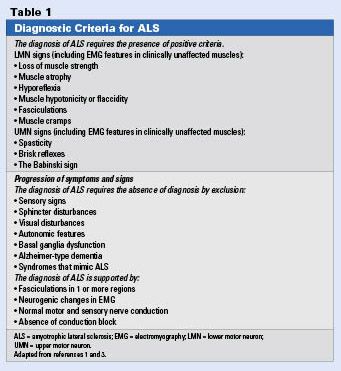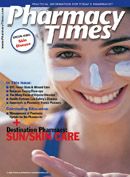Publication
Article
Pharmacy Times
Chronic Care Focus: Lou Gehrig's Disease
Author(s):
Ms. Wick is a senior clinical research pharmacist at the National Cancer Institute, National Institutes of Health, Bethesda, Maryland.
Amyotrophic lateral sclerosis (ALS or Lou Gehrig’s disease) is a group of diseases characterized by symptoms and signs of upper motor and lower motor neuron degeneration. 1,2 In typical cases, progressive muscle weakness ultimately leading to the inability to inflate one’s own lungs begins at a mean age of 47 to 52 years in familial cases and 58 to 63 years in sporadic cases3; brain functions, including oculomotor and sphincter functions, are usually—but not always— spared. Up to half of the patients with ALS develop cognitive dysfunction, and fewer than 5% develop dementia, usually frontotemporal type.4 Ultimately, ALS patients are frustrated by their inability to communicate, and clinicians also struggle with this issue.5,6
On average, patients die of respiratory failure 2 to 4 years after onset, but some may survive for >10 years.7 ALS is rare, with a lifetime risk of approximately 1:1000. Its risk factors include male sex, increasing age, and hereditary disposition.8
Table 1 describes the diagnostic criteria for ALS. Clinicians base diagnosis on symptoms, a thorough clinical examination, electrodiagnostic studies, neuroimaging, and laboratory studies. As with most diseases, early diagnosis— although difficult—allows the clinician to prescribe the sole neuroprotective agent that is FDA-approved for ALS, riluzole, and perhaps delaying progression and extending life, recognizing that no cure exists.9-13 Early intervention with medication can profoundly improve patients’ attitudes, and those of their caregivers.14 Patients also are better able to deal with ALS psychologically if diagnosed early, while they still have physical strength.

Differential diagnosis eliminates diseases that masquerade as ALS; there are many of them, and when ALS is suspected, clinicians should ensure that patients are seen by a specialist.15,16 If atypical symptoms develop or the patient does not progress, misdiagnosis, which is common, should be considered. 1,2,16 The best approach to managing ALS is multidisciplinary (Table 2), creating good working relationships with community-based care and service providers, but stressing and supporting patient autonomy and choice.17-21 Regular contact, even if by phone, between the team and the patient is best. Today, most teams try to use noninvasive ventilation when possible, pay close attention to nutrition, and refer earlier to palliative care services, as these steps extend survival.17,20
Neuroprotection
Riluzole 100 mg by mouth daily has been shown to slow ALS’s course, lengthening life by about 3 months after 18 months of treatment in clinical trials, probably because of its antiglutamate properties.11-13 In clinical practice, clinicians usually treat patients with 50 mg twice daily, and retrospective studies indicate that riluzole may extend overall survival gain from 6 to 20 months.22-24 Its most common side effects include asthenia, nausea, dizziness, decreased lung function, diarrhea, abdominal pain, pneumonia, vomiting, vertigo, circumoral paresthesia (numbness or tingling that occurs in the mucosa or tissues of the oral cavity), anorexia, and somnolence, with most of these dose-related. Riluzole may have little effect in late-stage ALS, and it remains unclear if or when treatment should be terminated.25
ALS’s symptoms can become intrusive and incapacitating quickly, so treating aggressively to improve patients’ quality of life is warranted.26
Sialorrhoea
Sialorrhoea (drooling or excessive salivation from impaired handling of saliva rather than from overproduction) is a socially disabling symptom and associated with increased likelihood of oral infections. Drugs that have bad reputations as heavily anticholinergic can be quite useful in ALS. Amitriptyline at doses of 25 to 50 mg 2 to 3 times a day is often effective and also inexpensive.27 Sublingual atropine drops 0.25 to 0.75 mg 3 times a day can decrease saliva production.17,28 Oral or transdermal hyoscine (scopolamine) also reduce salivary flow.29,30 Benztropine also has been found to be quite useful.31
If anticholinergics cannot be used, botulinum toxin type A injected into the salivary glands can decrease saliva for several months.32,33 Side effects can be limiting.34,35 External radiation of the parotid and submandibular glands also is simple and inexpensive, and may deliver good results.36-38 Most patients keep a portable mechanical suction device at home to help control sialorrhoea.
Bronchial Secretions
Bronchial secretions trouble patients, especially once respiratory insufficiency sets in. The mucosa of the nasal cavity, larynx, trachea, bronchial airways, and lungs contribute a constant flow of serous and particularly mucoid fluids. A high humidity environment helps. Here, too, patients and their caregivers use their portable home suction devices to clear upper airways and the mouth.
Secretions in lower airways can be difficult to reach, so prescribers rely on guaifenesin or N-acetylcysteine,
beta
-receptor antagonists, and/or anticholinergic bronchodilators like ipratropium and/ or theophylline to reach lower airways despite a lack of studies supporting their use.39 Manual assisted coughing and mechanical cough-assisting devices (insufflator-exsufflator) also help.40,41
Emotional Lability
As ALS progresses and brain lesions spread, about 50% of patients develop an emotional lability distinct from any mood disorder. Its pseudobulbar signs include pathological weeping, laughing, or yawning.42 A single study combining dextromethorphan and quinidine demonstrated improved emotional lability and quality of life, but most patients experienced side effects. Consequently, about one quarter of patients left the study because of them.43 Antidepressants, dopamine, and lithium are effective in other neurologic diseases,44-46 and may be useful in ALS.
Cramps and Spasticity
Cramps and spasticity plague ALS patients, and both respond well to massage, exercise, hydrotherapy, heat, cold, and physical therapy. Cramps tend to occur at bedtime.47 No drugs are FDA-approved for ALS’s cramps or spasticity.26 Antispastic drugs, including baclofen, are often used. Gabapentin (900-2400 mg daily), tizanidine (6-24 mg daily), memantine (10-60 mg daily), dantrolene (25-100 mg daily), tetrazepam (100-200 mg daily), diazepam (10-30 mg daily), and botulinum toxin A have been used with variable results.26,48,49
Mental Health Issues
Depression, insomnia, and anxiety occur frequently at all stages of ALS, and become pronounced when respiratory insufficiency develops and communication becomes impaired.50 Amitriptyline (capitalizing on its anticholinergic side effects) and selective serotonin reuptake inhibitors are used for depression. Clinicians should individualize treatment for insomnia and anxiety.27
Pain, VTE Prevention, and Enteral Nutrition
Pain, the potential for venous thromboembolic (VTE) thrombosis secondary to immobilization, and enteral nutrition are all concerns as ALS progresses. For pain, clinicians should employ the World Health Organization analgesic ladder guidelines when nonnarcotic analgesics are no longer effective.51 As with other opioid patients, ALS patients may be troubled by constipation.
Similarly, following accepted guidelines for VTE prevention and enteral nutrition is prudent.
Conclusion
Sadly, ALS patients will need end-of-life care. Involving the patient and his or her family from the beginning of treatment will ensure that his or her wishes are known and respected. â–










